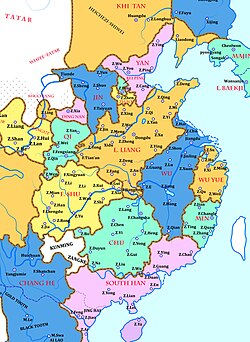Min (Ten Kingdoms)
Min 閩 | |||||||||||||
|---|---|---|---|---|---|---|---|---|---|---|---|---|---|
| 909–945 | |||||||||||||
 | |||||||||||||
| Capital | Changle | ||||||||||||
| Common languages | Middle Chinese, Proto-Min | ||||||||||||
| Government | Monarchy | ||||||||||||
| King/Emperor | |||||||||||||
• 909–925 | Wang Shenzhi | ||||||||||||
• 943–945 | Wang Yanzheng | ||||||||||||
| Historical era | Five Dynasties and Ten Kingdoms Period | ||||||||||||
• Wang Shenzhi became the Prince | 909 909 | ||||||||||||
• Wang Yanjun declared himself the Emperor | 933 | ||||||||||||
• Independence of Yin | 943 | ||||||||||||
• Ended by Southern Tang | 945 945 | ||||||||||||
| |||||||||||||
| Min | |||||||||||
|---|---|---|---|---|---|---|---|---|---|---|---|
| Traditional Chinese | 閩國 | ||||||||||
| Simplified Chinese | 闽国 | ||||||||||
| |||||||||||
Min (Chinese: 閩; pinyin: Mǐn) was one of the Ten Kingdoms which was in existence between the years of 909 and 945. It existed in a mountainous region of modern-day Fujian province of China and had a history of quasi-independent rule. Its capital was Fuzhou. It was founded by Wang Shenzhi.
Founding
Wang Shenzhi’s older brother Wang Chao was given the title of Surveillance Commissioner in 892. Wang Shenzhi himself was named military commissioner, and in 909, in the wake of the collapse of the Tang Dynasty two years earlier, named himself the Prince of Min. Wang Shenzhi’s son declared himself the Emperor of Min in 933. At that point, his father was posthumously named Min Taizu.
The early Chinese exonym Min (閩) was a graphic pejorative written with Radical 142 虫, the "insect" or "reptile" radical. Xu Shen's (c. 121 CE) Shuowen Jiezi dictionary defines min as:[1] "Southeastern Yue [i.e., Viet]; snake race. [The character is formed] from [the] insect / serpent [radical and takes its pronunciation from] mén.
Territorial extent
The capital of the Min Kingdom was Changle, now known as Fuzhou. The kingdom was essentially limited to modern-day Fujian Province in China’s southeast.
Administration
The territory of the Min was relatively isolated and rugged, thus not as economically prosperous as other regions of the Chinese realm. The Min court attempted to attract scholars that would assist in constructing an effective bureaucratic and tax system to bring the kingdom up to contemporary standards. Maritime trade developed over this period of time. This would set the stage for a successful regional maritime trade that could continue during future Chinese dynasties.
Yin Kingdom
In 943, one of Wang Shenzhi’s sons rebelled and declared independence from the Min in the northwest of the territory of the kingdom, proclaiming the Yin dynasty. The Min court asked the Southern Tang for assistance in quelling the rebellion in Yin. Rather than assisting the Min government, the Southern Tang came in and absorbed the territory into its own holdings.
Fall of the Min
Seeing the threat posed by the Southern Tang, the Min court declared its allegiance to the Wuyue kingdom to its north. However, this did not stop the Southern Tang from marching in and incorporating the remainder of the Min Kingdom into its holdings in 945
Rulers of Min
| Temple Names | Posthumous Names | Personal Names | Period of Reigns | Era Names and dates |
|---|---|---|---|---|
| Tàizǔ (太祖) | Zhōngyì Wáng (忠懿王) | Wáng Shěnzhī (王審知) | 909–925 | Did not exist |
| Did not exist | Did not exist | Wáng Yánhàn (王延翰) | 925–926 | Did not exist |
| Hùizōng (惠宗) | Qísù Míngxiào Huángdì (齊肅明孝皇帝) | Wáng Yànjūn (王延鈞) | 926–935 | Lóngqǐ (龍啟) 933–935 Yǒnghé (永和) 935 |
| Kāngzōng (康宗) | Too tedious thus not used when referring to this sovereign | Wáng Jìpéng (王繼鵬) | 935–939 | Tōngwén (通文) 936–939 |
| Jǐngzōng (景宗) | Too tedious thus not used when referring to this sovereign | Wáng Yánxī (王延羲) | 939–944 | Yǒnglóng (永隆) 939–944 |
| Did not exist | Did not exist | Zhū Wénjìn (朱文進) | 944–945 | Did not exist |
| Did not exist | Tiāndé Dì (天德帝) (both as Emperor of Yin and Emperor of Min) | Wáng Yánzhèng (王延政) | 943–945 | Tiāndé (天德) 943–945 |
Rulers family tree of Min
| Rulers family tree | ||||||||||||||||||||||||||||||||||||||||||||||||||||||||||||||||||||||||||||||||||||||||||||||||||||||||||||||||||||||||||||||||||||||||||||||||||||||||||||||||||||||||||||||||||||||||
|---|---|---|---|---|---|---|---|---|---|---|---|---|---|---|---|---|---|---|---|---|---|---|---|---|---|---|---|---|---|---|---|---|---|---|---|---|---|---|---|---|---|---|---|---|---|---|---|---|---|---|---|---|---|---|---|---|---|---|---|---|---|---|---|---|---|---|---|---|---|---|---|---|---|---|---|---|---|---|---|---|---|---|---|---|---|---|---|---|---|---|---|---|---|---|---|---|---|---|---|---|---|---|---|---|---|---|---|---|---|---|---|---|---|---|---|---|---|---|---|---|---|---|---|---|---|---|---|---|---|---|---|---|---|---|---|---|---|---|---|---|---|---|---|---|---|---|---|---|---|---|---|---|---|---|---|---|---|---|---|---|---|---|---|---|---|---|---|---|---|---|---|---|---|---|---|---|---|---|---|---|---|---|---|---|
| ||||||||||||||||||||||||||||||||||||||||||||||||||||||||||||||||||||||||||||||||||||||||||||||||||||||||||||||||||||||||||||||||||||||||||||||||||||||||||||||||||||||||||||||||||||||||
References
- ^ Mair, V. H. (2003). "How to Forget Your Mother Tongue and Remember Your National Language". Quotation translated from Chinese ("東南越蛇穜从虫門聲")
Sources
- Schafer, Edward H. (1954). The Empire of Min. Tuttle. OCLC 845108660.
- Mote, F.W. (1999). Imperial China (900-1800). Harvard Univ. Press. pp. 15–16. ISBN 0674012127.
- Theobald, Ulrich. "Min 閩". Chinese History - The Ten Kingdoms 十國 (902-979). Retrieved 18 May 2005.
